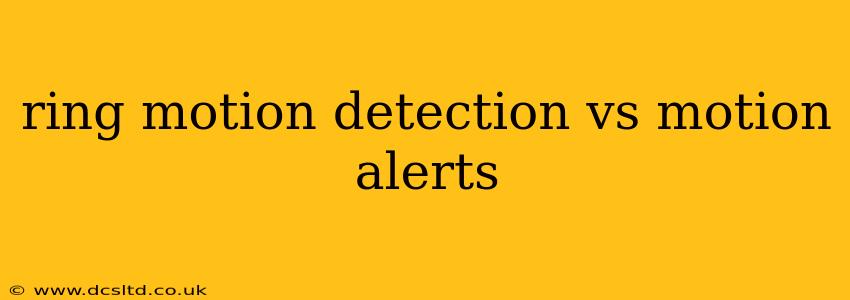Ring security cameras offer a powerful suite of features designed to keep your home safe and secure. Two key features often cause confusion: motion detection and motion alerts. While they work together, they are distinct functionalities with different purposes. This article will clarify the differences, helping you understand how to optimize your Ring system for maximum effectiveness.
What is Ring Motion Detection?
Ring motion detection is the underlying technology that senses movement within your camera's field of view. The camera constantly analyzes the video feed, comparing each frame to the previous one. Any significant change – a person walking, a car driving by, even a swaying tree branch – triggers the detection system. This raw data is then processed and used to determine whether or not to send you an alert. Think of it as the engine; it's constantly running, constantly monitoring. The sensitivity of this detection can usually be adjusted in your Ring app settings.
What are Ring Motion Alerts?
Ring motion alerts are the notifications you receive when motion detection identifies something significant. These alerts can be customized to your preferences. You can choose to receive push notifications to your smartphone, email alerts, or both. Crucially, you can also define what triggers an alert. This is where the customization comes into play. You can adjust sensitivity, define specific zones within your camera's view to monitor (ignoring, for example, a busy street), and even filter out certain types of movement (like pets).
What's the difference between motion detection and recording?
While many associate motion detection with recording, they are not the same. Motion detection triggers recording, but it doesn't necessarily mean the camera is constantly recording. Many Ring camera plans allow for continuous recording, even without triggered motion. However, motion detection provides the option to only record when motion is detected, saving storage space and battery life.
Can I turn off motion detection?
Technically, you can't completely turn off motion detection, as it's the underlying mechanism that allows the camera to detect movement. However, you can significantly reduce the frequency of alerts by lowering the sensitivity or creating custom motion zones. You can essentially make it so insensitive that it almost never triggers an alert. This might be useful if, for example, you only need the camera for recording during specific events, and the constant alerts are annoying.
How can I adjust the sensitivity of my Ring motion detection?
The sensitivity setting dictates how easily the camera detects movement. A higher sensitivity means the camera is more likely to detect even small movements, potentially resulting in more alerts (and potentially more false alarms). A lower sensitivity requires more substantial movement to trigger a detection, reducing alerts but possibly missing smaller events. The optimal setting depends on your environment and specific needs. Experiment to find the sweet spot between capturing important events and minimizing false positives.
Why am I getting so many motion alerts?
Several factors can contribute to excessive motion alerts:
- High sensitivity setting: Lowering the sensitivity can significantly reduce the number of alerts.
- Poorly defined motion zones: Ensure your motion zones accurately reflect the areas you want to monitor, avoiding areas with frequent, unimportant movement (leaves blowing, etc.).
- Environmental factors: Animals, swaying branches, or even reflections can trigger alerts. Carefully adjust your settings and zones to minimize false positives.
- Camera placement: Consider the placement of your camera; poor placement can lead to frequent unwanted triggers.
By understanding the distinction between Ring motion detection and motion alerts, you can fine-tune your Ring camera system to optimize its performance and effectively safeguard your property. Remember to regularly review your settings and adjust as needed to maintain the balance between security and alert management.
